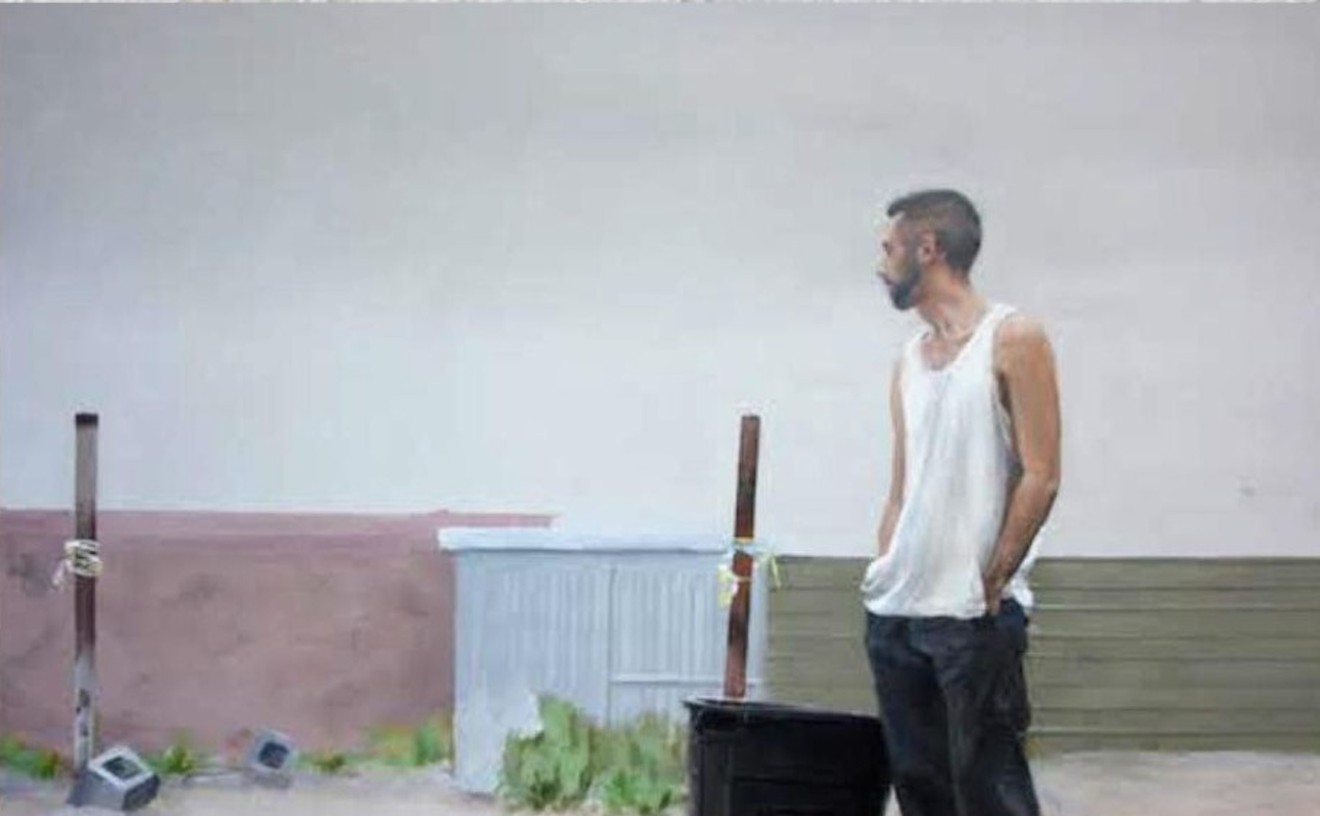Scott Holloway's "A Solo Exhibition of New Work" includes beautifully crafted works that he cleverly pares down, often including only a single image in each piece. The 40-year-old Massachusetts-based artist has mastered the ability to entice heavy reflection from his viewers via simple visuals. With a background in realist portraiture and landscape, Holloway latched on to anatomy illustrations and the Renaissance as a student 15 years ago.
His most recent works at Perihelion Arts include realist drawings and paintings that mash up Christian iconography, biblical text, and anatomical renderings — many made with similar materials, techniques, and styles employed by the Italian Renaissance artists. The symbolic imagery is taken out of the Renaissance context and repositioned in stark, bare atmospheres. Each work is no larger than a piece of notebook paper, and though their intimate size may cause them to appear soft-spoken, they eagerly tackle God, the Bible, science, and love.
The show, up until the end of the month in the gallery along Roosevelt Row, is split into three series: Holy Relics, Adam, and Sacred Heart.
You know you're looking at one of the pieces in the Adam Series when you see a human skull. Adam's skull often pops up in Renaissance Christian paintings, frequently placed at the base of Jesus' cross. It symbolizes original sin. (Adam was the first man to sin in the Garden of Eden by chomping the forbidden fruit, after all.)
In Saint I, splattered stains of lavender and bronze pigment litter an ivory-colored sheet of paper. A skull is rendered in pencil and surrounded by a gold-leaf halo. It is tilted up, as if it's looking to the sky. The angle exposes its incomplete top row of teeth and reveals the gaping holes left from decay. There is no lower jaw. Here, Holloway uses his anatomical know-how to redefine a Christian symbol.
As someone who faked Episcopal and Catholic faith during her entire childhood only to eventually give it up, I see the deterioration of Christianity in this work. Perhaps if I were more pious, I'd see an assertion of the everlasting nature of Christianity or interpret an encouragement to worship. But because spirituality is such a personal thing, I can only project my own meaning.
And that's the point of Holloway's show. He forces his audience to consider the Christian God. No matter what you believe (or don't believe), Christianity plays a role — both in the gallery and in our society. Holloway successfully forces each viewer to assess his own, unique relationship with Christianity.
Most of the pieces in the Adam Series are created with pencil on paper and look like pages ripped from a Renaissance master's sketchbook. The Sacred Heart Series, on the other hand, features polished oil on panel paintings.
These are easy to identify because each includes an image of a heart. A simple work, predictably titled Sacred Heart, has a background dominated, once again, by gold leaf and splattered pigments. The burgundy heart looks as if it were copied from a Renaissance medical journal. Floating in the center of the painting, it is completely severed from its human host. The word "love" is scrawled underneath it.
While the imagery is somewhat grotesque, the piece stirs feelings of affection. This human organ can't be disgusting when it's the source of such a beautiful emotion. Holloway reveals that even a harsh scientific painting style can't strip the heart of its symbolism.
For the faithless, it's natural to assume the "sacred" nature of this work has nothing to do with Christianity. The exposed organ is revered because of its emotional connotations and nothing else. But a Christian might associate this with God's eternal love.
Holloway includes more anatomical paintings in his Holy Relic Series. These focus on St. Luke, who is the patron saint of artists, sculptors, and surgeons. The human hand is St. Luke's symbol and acts as the identifying feature of this series.
Hand I and Hand II are, by far, the most morbid pieces of the show. The paintings each feature a single human hand, chopped off at the wrist. The fingertips are still intact, but the skin is removed from the rest of the severed hands. The glowing white tendons pop against the exposed, terra cotta-colored muscles; glistening crimson veins trail over gray bones.
They're gruesome, but not without purpose. Holloway communicates through symbolism, and it's understood that the careful dissection represents the study and constant reinterpretation of the Gospel (a portion of the Bible that describes the life of Jesus) according to Luke.
The show's three series weave Christian symbolism and Renaissance style — seamlessly complementing one another. The exhibition is interrupted, however, by Eye, a random piece that Perihelion really could have done without. All the other artworks are framed pictures that line the walls, except for his unique piece of jewelry, displayed on a lone pedestal. Holloway painted a beautiful blue eye on a thin piece of wood, about the size of the palm of a hand. A massive tangle of pink, beige, and ivory beads surrounds the image and tapers to become the chain of a necklace. It's not a horrible piece of art, but it hijacks the exhibition's flow.
Aside from Eye, the show is a careful collection of Holloway's ambitious explorations of complicated concepts. One would think an art exhibition that takes on God, the Bible, science, and love — all at once — would be a total mess. Holloway, however, pulls it off by keeping the imagery simple and open to interpretation for the faithful and the heathens alike.










